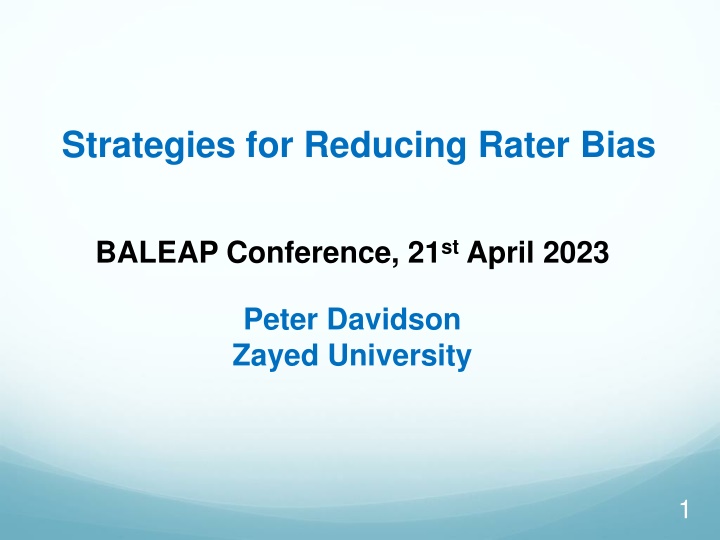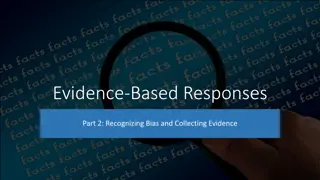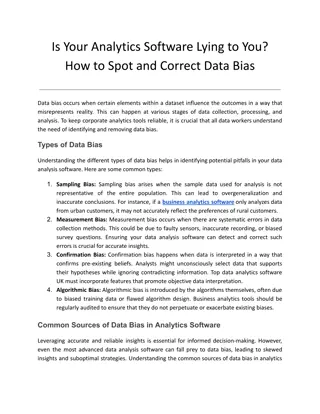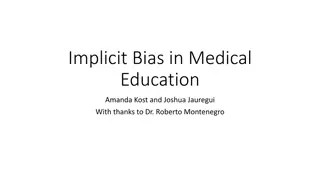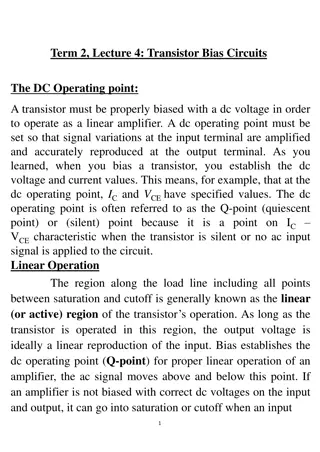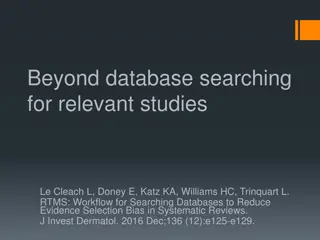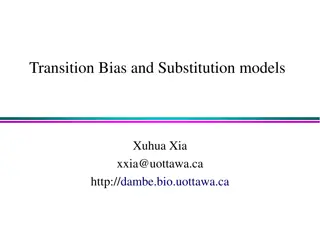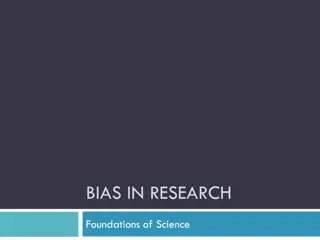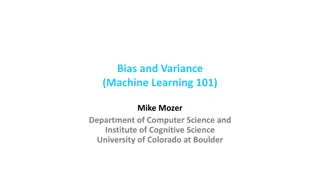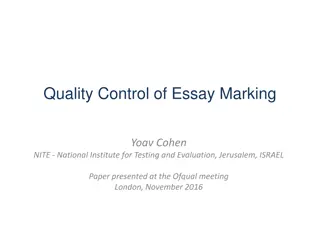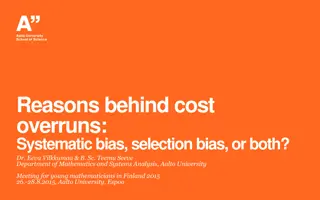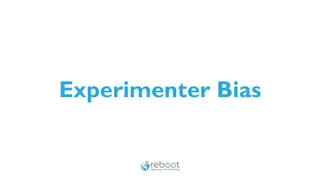Reducing Rater Bias: Strategies and Impact
Rater bias, a systematic behavior pattern affecting assessment ratings, can undermine assessment reliability. Explore various biases, manifestations, and defense for human raters. Discover strategies to mitigate bias and enhance rating consistency and reliability.
Uploaded on Apr 04, 2025 | 2 Views
Download Presentation

Please find below an Image/Link to download the presentation.
The content on the website is provided AS IS for your information and personal use only. It may not be sold, licensed, or shared on other websites without obtaining consent from the author.If you encounter any issues during the download, it is possible that the publisher has removed the file from their server.
You are allowed to download the files provided on this website for personal or commercial use, subject to the condition that they are used lawfully. All files are the property of their respective owners.
The content on the website is provided AS IS for your information and personal use only. It may not be sold, licensed, or shared on other websites without obtaining consent from the author.
E N D
Presentation Transcript
Strategies for Reducing Rater Bias BALEAP Conference, 21st April 2023 Peter Davidson Zayed University 1
Outline 1. Introduction 2. What is Rater Bias? 3. Bias Rating Behaviour 3.1 Characteristics of the rater 3.2 Characteristics of the candidate 4. Research on Rater Variability 5. The Manifestation of Rater Variability and Inconsistency between Raters 6. In Defence of the Human Rater 7. How to Reduce Rater Bias 7.1 Improving internal consistency 7.2 Improving inter-rater reliability
1. Introduction Weir (2005: 56): The last decade of the twentieth century saw a general decline in the prestige of psychometric, statistically-driven approaches to testing. Covid-19 has exacerbated this shift move away from the use of discrete skill tests move towards more holistic, authentic and integrated assessment task-based / performance-based / scenario-based essays / case studies / reports / projects / research papers / portfolios / seminars / presentations greater emphasis on subjective human raters the reliability of the assessment could be compromised need to mitigate against rater bias
2. What is Rater Bias? Rater bias refers to a systematic pattern of rater behavior that manifests itself in unusually severe (or lenient) ratings associated with a particular aspect of the assessment situation (Eckes, 2012, p. 273). Differential rating functioning: when a rater shows high degrees of severity (or leniency) with a particular group of candidates (e.g. females or Russians), or a particular task (instruction manual or a presentation), or a particular criterion (e.g. grammar or fluency). Can be determined by Many Facet Rasch Model (MFRM)
3. Bias Rating Behaviour 3.1 Characteristics of the rater 1. Leniency Bias: the tendency of a rater to score too leniently 2. Harshness Bias: the tendency of a rater to score too severely or too harshly 3. Central Tendency Bias: the tendency of a rater to score near the center of a scale 4. Restriction of Range Bias: the tendency of a rater to limit their range of scores 5. The Halo Effect Bias: the tendency of a rater that gives a high rating on one part of criteria, to give high ratings on other parts of the criteria 6. The Horns Effect Bias: the tendency of a rater that gives a low rating on one part of criteria, to give low ratings on other parts of the criteria
3. Bias Rating Behaviour 3.1 Characteristics of the rater 7. The Contrast Effect Bias: the tendency of a rater to compare one performance with another performance 8. First Impression Bias: the tendency of a rater to be strongly influenced by the beginning of a performance 9. Recency Bias: the tendency of a rater to be strongly influenced by the end of a performance 10. Current State of Mind Bias: the tendency of a rater to be influenced by their current state of mind
3. Bias Rating Behaviour 3.2 Characteristics of the candidate 11. Acquaintanceship Bias: the tendency of the rater to score candidates they know higher (or lower) 12. Expectation / Confirmation Bias: the tendency of a rater to be influenced by their expectations of the candidate 13. Similarity Bias: the tendency of a rater to be influenced by how similar the candidate is to them 14. Cultural Familiarity Bias: the tendency of a rater to be influenced by how familiar they are with a certain culture 15. Ethnicity Bias: the tendency of a rater to be influenced by the ethnicity of the candidate 16. Gender Bias: the tendency of a rater to be influenced by the gender of the candidate
3. Bias Rating Behaviour 3.2 Characteristics of the candidate 17. Sexual Orientation Bias: the tendency of a rater to be influenced by the sexual orientation of the candidate 18. Social Status Bias: the tendency of a rater to be influenced by the social status of the candidate 19. Age Bias: the tendency of a rater to be influenced by the age of the candidate 20. Attitude Bias: the tendency of a rater to be influenced by the attitude of the candidate 21. Handwriting Bias: the tendency of a rater to be influenced by the quality of handwriting of the candidate 22. Sympathy Bias: the tendency of a rater to score a candidate they feel sympathy for higher
4. Research on Rater Variability Edgeworth (1890): expressed concern that only a third to two-thirds of successful candidates would pass public exams again if given a different set of judges Diederich et al. (1961): 53 raters scored 300 scripts on a 9-point scale 94% of papers received at least 7 grades; no paper received less than 5 grades Weigle (1998): 16 raters scored 60 scripts before and after training Before training, inexperienced raters were more severe and less consistent than experienced raters After training, inexperienced raters were still more severe than experienced raters, but were more consistent
4. Research on Rater Variability Schaefer (2008): 40 raters scored 40 scripts If Content and Organization were scored severely, then Language Use and Mechanics were scored leniently There tended to be more severe or lenient bias with higher level candidates Yousun (2010): 3 raters scored 254 scripts Grammar was scored most severely, while Organization most leniently Erguvan & Dunya (2020): 3 raters scored 109 scripts between them, and 6 anchor scripts Raters were internally consistent, but the range of scores was restricted, and there was no inter-rater reliability
5. The Manifestation of Rater Variability and Inconsistency between Raters (Eckes, 2008) Raters may differ in the: degree to which they comply with the scoring rubric way they interpret criteria employed in operational scoring sessions degree of severity or leniency exhibited when scoring examinee performance understanding and use of rating scale categories degree to which their ratings are consistent across examinees, scoring criteria, and performance tasks
6. In Defence of the Human Rater high cognitive demand multi-tasking focus on a number of different criteria and descriptors multiple candidates (in speaking) multiple roles erratic performances pressure of being monitored time pressure fatigue
7. How to Reduce Rater Bias 7.1 Improving internal consistency acknowledge the potential for rater bias be aware of different types of rater bias behavior be aware of your own rater bias participate in regular training sessions participate in regular norming / moderation / standardization / calibration sessions rate blind (to avoid confirmation bias) use a well-defined rubric (scoring criteria) with clear, logical descriptors create an answer template devise a rating schedule with regular breaks avoid distractions when rating rate all of one question type together rate all of one question type in the same sitting
7. How to reduce rater bias 7.2 Improving inter-rater reliability conduct regular training sessions conduct regular norming / moderation / standardization / calibration sessions get raters to rate blind (to avoid confirmation bias) use double or multiple raters use a well-defined rubric (scoring criteria) with clear, logical descriptors have all raters rate in the same room at the same time have a clear moderation policy use rater moderation where necessary monitor raters regularly provide raters with feedback on monitoring use FACETS to identify rater bias use a limited pool of raters use automated essay scoring
References Bachman, L.F., Lynch, B., and Mason M. (1995). Investigating variability in tasks and rater judgment in a performance test of foreign speaking. Language Testing, 12(2), 238-237. Brown, J.D. (1991). Do English and ESL instructors rate samples differently? TESOL Quarterly, 25(4), 587-603. Deiderich, P.B., French, J.W, and Carlton, S.T. (1961). Factors in judgements of writing ability. Research Bulletin 61-15. Princeton, N.J. ETS. Eckes, T. (2008). Rater types in writing performance assessments: A classification approach to rater variability. Language Testing, 25(2), 155-185. Eckes, T. (2012). Operational rater types in writing assessment: Linking rater cognition to rater behavior. Language Assessment Quarterly, 9(3), 270-292. Edgeworth, F.Y. (1890). The element of chance in competitive examinations. Journal of the Royal Statistical Society 53, 460-475 and 644-663.
References Erguvan, I.N. and Dunya, B.A. (2020). Analyzing rater severity in a freshman composition course using many facet Rasch measurement. Language Testing in Asia, 10(1), 1-20. Lumley, T. and McNamara, T.F. (1995). Rater characteristics and rater bias: implications and training. Language Testing, 12(1), 54-71. Schaefer, E. (2008). Rater bias patterns in an EFL writing assessment. Language Testing, 25(4), 465-493. Weigle, S. C. (1998). Using FACETS to model rater training effects. Language Testing, 15(2), 263 287. Weir, C.J. (2005). Language Testing and Validation. Palgrave Macmillan, London. Yousun, S. (2010). A FACETS analysis of rater characteristics and rater bias in measuring L2 writing performance. English Language and Literature Teaching, 16(1), 123-142.
